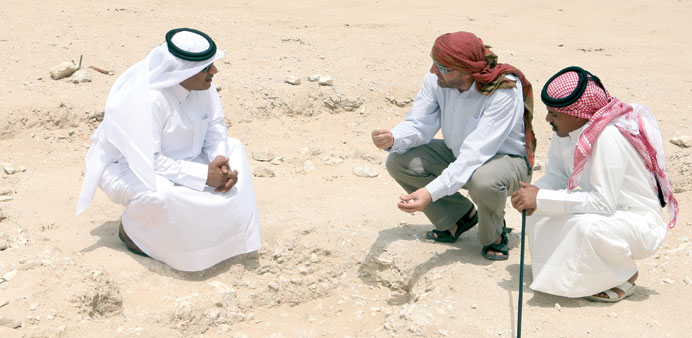|
Qatar’s oldest settlement, Wadi Debayan, presents a “wonderfully detailed and historically rich fantastic story” of human occupation and development in the region, an archaeologist engaged in the excavation of the site has told Gulf Times. |
One of the earliest Neolithic-Chalcolithic sites in the Gulf, Wadi Debayan had human occupation 7,500 years ago, as proven in the past three years of excavation conducted as part of the Qatar National Historic Environment Record (QNHER) Project.
“The pre-history, history and heritage of Qatar are here, under this apparently empty ground,” explained site superviser Peter Spencer, a member of the University of Birmingham team that is jointly developing the QNHER Project with the Qatar Museums Authority under the guidance of Faisal
al-Naimi (Head of Antiquities).
QNHER Project co-director Richard Cuttler, a research fellow at the University of Birmingham, explained that the site, which has recently seen the completion of a season of archaeological excavation, has expanded beyond
all expectations.
Faisal al-Naimi
“In the first year we found a flint scatter and some shards of pottery, which in many cases is all that remains. But, we later realised that the site is very important and to find such extensive Neolithic occupation is stunning,” he said.
Spencer observed that virtually every area excavated in Wadi Debayan has shown a new chronological period spanning approximately 3,000 years, which is a massive period of time to have such detailed information about human occupation. Settlement commenced around 7,500 years ago and appears to have ended abruptly with a high-energy event, may be a tsunami, shortly after 4,500 years ago.
“We are building up a really nice picture of the landscape’s spatial distribution. Now, we will pull together all the environmental and stratigraphic data, and all radiocarbon dates into a single volume. We hope to have a draft version by early next year,” he said.
Based on the data so far unearthed from Wadi Debayan, Cuttler thinks his team is beginning to show that Qatar was on the edge of a monsoon belt that moved northwards from southern Oman between 10,000 and 6,000 years ago. Further to the north of Qatar, it probably remained hyper arid and very dry.
“We have adopted more of a landscape or environmental approach to try and understand the wider picture. This is because no site stands alone, but is part of the landscape, not only with other sites of the same period but also within the context of changing vegetation, environment, sea level and so on. We have had such a great opportunity with Wadi Debayan because it has not been previously lost to development,” he said.
A salient feature of Wadi Debayan is that excavation in different parts of the site throws up proof for occupation of varying periods. It may be not the same group of people, but there is occupation from around 7,500 years ago through to about 4,500 years ago.
“There are certainly some great early Neolithic sites in the region, but they tend to span only a short period of time, may be a few hundred years or so, whereas Wadi Debayan’s history is unparalleled,” Cuttler added.



